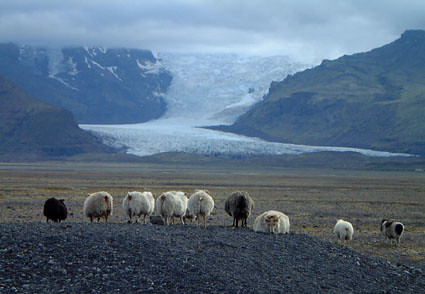
There are not many wild or domesticated local animals in Iceland, but the wildlife and farm animals Iceland do have are very special. Did you know there are more Icelandic sheep in Iceland than people?! Some farmers own nearly a thousand sheep of their own. The extensive farm land around Iceland's coast is full of them, and every summer they roam the highlands and mountains freely. They're tough, sturdy little animals, and grow lots of fluffy wool that the Icelanders use to make all their woollen goods from, also called LOPI wool. Icelandic sheep are a breed that has remained virtually unchanged for over 1,000 years, maybe the oldest and most genetically pure sheep breed in the world. Modern Icelandic sheep descend from sheep ferried by Vikings to Iceland during the 8th and 9th Centuries. Attempts to “improve” the breed by outcrossing generally resulted in increased vulnerability to disease, and so raisers on this island nation decided to keep their selective breeding attempts confined within the breed.
The Icelandic sheep is an ancient North European breed, slightly smaller than modern varieties, whose double-layered coat is uniquely suited to cold and wet conditions. The inner layer, or thel, is insulating, superlight and very airy, while the outer layer, or tog, is long, strong and water repellent. Carded together, these two layers make lopi, versatile wool used to knit lopapeysa, the distinctive traditional Icelandic sweater. Wool from the spring shearing is coarse and generally used to make carpets, while prized lopi wool comes from the autumn shearing.
A few weeks after the lambing in May, sheep are sent to run free and graze in mountain pastures until autumn, feeding on the rich and nourishing vegetation. Many farmers formerly allowed their sheep to graze in outlying pastures over the summer months, but as a result of the recent reduction in flocks, animals are increasingly kept on home pastures. Farmers gather their flocks in the autumn. Usually, the round-up is carried out on horseback with assistance of sheepdogs. The process can take up to a week. During this time, participants stay overnight in mountain huts located throughout the highlands. Each sheep farmer has his own earmark in order to identify his livestock. After the gathering, the sheep are all sorted into designated pens, according to earmarks. Many people, farmers or not, come to watch or take part in this event on the last day, which is usually followed by a big celebration the same night. This is a tradition cherished by Icelanders.
Icelandic sheep are a beautiful and eye-catching breed of sheep with incredible colour variations and seventeen possible combinations of colours and patterns. Known around the world for their fibre, the Icelandic sheep provides a soft, lustrous dual coated fleece. Icelandic sheep come in a range of natural colours and patterns which provide lovely wool that is very versatile and easy to spin, making this wool a handspinners delight.
Like I said before, Icelandic fleece is dual-coated. In Icelandic the long outer coat is called tog and the fine inner coat þel. When separated, the outer and inner coats are used for different woolen products.
Tog is generally classified as a medium wool around 27 micron. It is good for weaving and other durable products.
Thel, being the finer wool and classified as such, is generally around 20 micron. Tog and Thel are processed together to produce lopi, a distinctive knitting wool that is only made from the fleece of Icelandic sheep.
Last year I was able to offer you a very special rare sheep breed adventure called the Icelandic Leadersheep adventure that not many people knew anything about. This week I offer you carefully selected beautiful mid grey Icelandic tops of the prized autumn shearing and exquisitely soft too. PLUS!!! I have a very very VERY limited amount of the Leadersheep tops on offer as well and they combine very well with the grey autumn shearing of their Icelandic sheep brothers and sisters.
Something about the Leadersheep for those who have missed the info in last year’s blog entry: Every farmer on Iceland may have one or two or a maximum of say 10 of these animals in their flock. Not more. All in all there are about 1500 Forystufe sheep in existence today and that is one of the reasons why this rare sheep breed adventure was so hard to organise..obviously.
What are “Forystufe” I hear you say? Well, they are also called Icelandic Leader Sheep. The Icelandic leader sheep is a separate line within the Icelandic breed of sheep . The Leader sheep were probably brought to Iceland together with other sheep at the time of settlement in the 8th and 9th century. The sheep are lightly built with long legs and not as heavy as the Icelandic sheep, but otherwise similar. The leader sheep are known for their leader characteristics and a specific sense of directions, that were highly valued traits under the extensive farming conditions in Iceland in earlier times.
The leader sheep were used to bring the flock home in bad weather during winter grazing and they are still used to lead the flock when sheep are moved to and from summer pastures. The leader sheep are now a small population of around 1,500 purebred adult sheep that are spread between many flocks, with a few leader sheep on each farm. Leader rams have been kept at the AI stations in Iceland since 1981 as an aid to the conservation of the leader sheep. They are known best for their leadership characteristics. Many old stories tell how people and sheep have been lost in the Icelandic Highlands and Icelandic storms but were rescued and brought to safety by these special sheep. They remain calm, walk in front of the flock, and are alert to any impending danger. They will even bring the sheep down early if they sense danger. A special gene pool keeps these sheep with outstanding leadership abilities alive: These sheep are only bred to each other to keep the genetic tendencies strong. They are highly intelligent. Their sense of direction and ability to forecast impending bad weather are uncanny. The leadersheep are used when the farmers move the sheep from the home pastures up to the summer grazing area and then back home again before winter. Leader-sheep are more primitive than the modern Icelandic sheep. No comparable sheep are found elsewhere in the world !
Here are some photos of beautiful Iceland and its’ sheep :
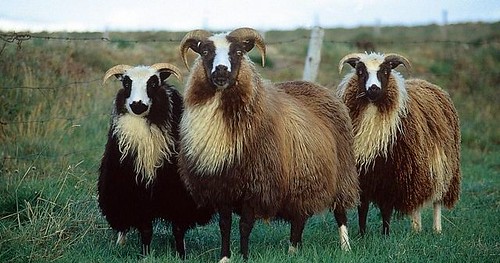
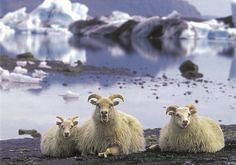
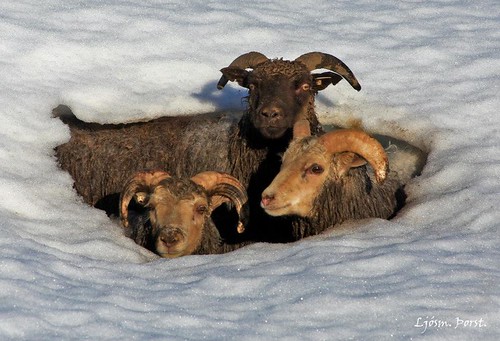
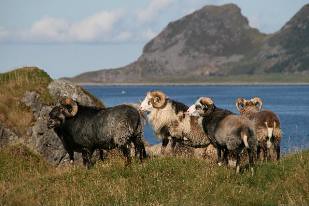
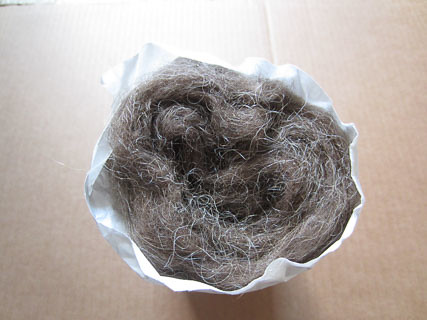
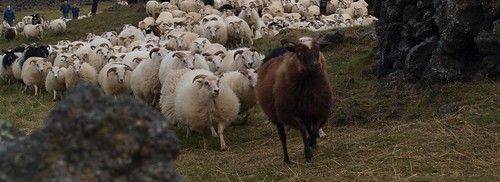
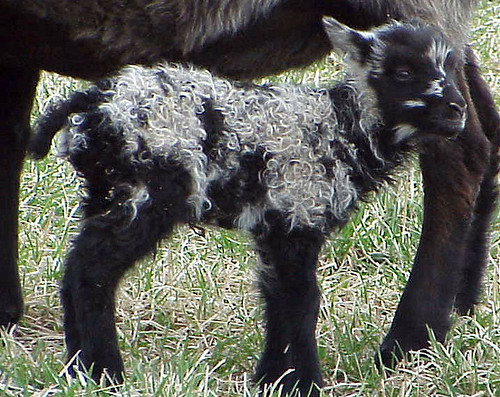
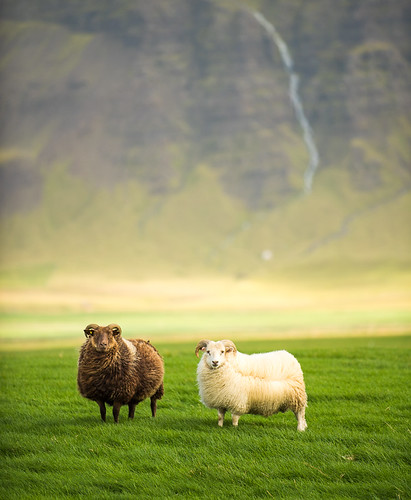
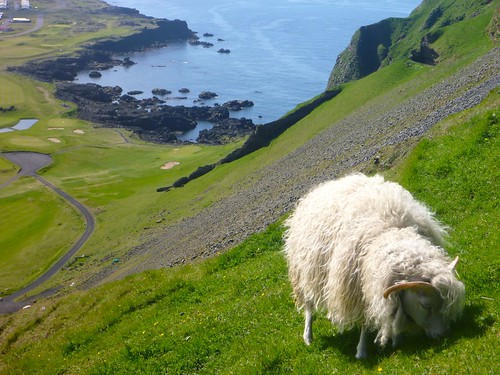
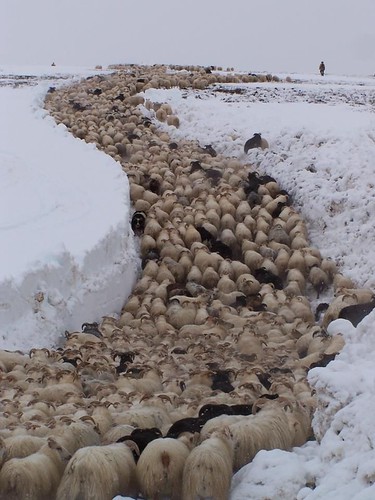
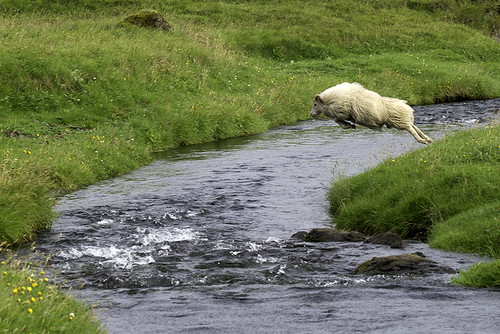
Here are two interesting videos on the Icelandic Leadersheep :
As the name implies these sheep were leaders in their flocks. Through the centuries they have played a very important part in survival in Iceland. The geographical location of the country makes habitation difficult, and, especially during winter, the weather is extremely changeable and often dangerous for both humans and animals.
With a growing season of only three months, hay was usually in short supply for most farmers until the middle of this century when modern farming methods increased hay yield. Animal and human survival often depended on a considerable amount of winter grazing of the sheep, which often were the only livestock a farmer had. The sheep flocks were usually driven by the shepherds several kilometres from the farm to the pastures where they scraped the snow to find whatever vegetation was available. Often the shepherds were just children from twelve years old and sometimes they had to stay with the sheep during the day. It was a tough life that required both ingenuity and strength.
The leadersheep had many qualities that made them special. Often they were very tame and loved humans, but always the other animals in the flock followed them blindly with a complete trust. The shepherd also trusted the instincts of these sheep and that trust often saved humans and sheep from certain death.
The leadersheep usually had an acute sense of the weather. They could sense change on the way often a whole day before a deadly blizzard hit. In these instances they often refused to leave the barn to go on pasture. If the weather was good and going to stay that way the leader usually was the first sheep out in the morning. If, on the other hand, the leader stayed in the barn, not to mention if they refused to leave, it indicated bad weather. Woe the shepherd who ignored the forecast of their leadersheep.
Often, when the weather appeared good, the leader and the whole flock was forced out. In these cases the leader usually did his best to stop the flock or at least tried to delay the driving. Then on pasture they usually did not graze but stood alert and at the first sign of weather change, they rounded up the flock and headed home. The weather in Iceland is extremely changeable and often it takes less than an hour to change from sunshine to raging blizzard. In many cases when flocks were caught in that kind of a situation the leader found the way home even though the shepherd was totally lost. The shepherd trusted the ability of the sheep to find the way. A good leader would go home as fast as possible, though never faster than a speed which allowed all of the sheep to keep up. Some of the leaders were exceptionally good at finding ways over treacherous ground where the whole flock could follow. The same applied to finding fording places across rivers. Some were good at finding good places to graze in the winter. But all had an amazing ability to find their way home. Many could be trained to follow signs from the shepherd, not unlike a good dog can. Many stories are told about instances where farmers had difficulty in getting skittish sheep from one place to another. Then the leader was sent off and usually the difficult sheep followed him without hesitation.
The leadership ability runs in bloodlines and is equal in males and females. There were farmers who bred leadersheep and these were usually priced two or three times over what good sheep traded for. Bloodlines even became famous for their ability and were sought after. I have been told that leadersheep are often taller than other sheep, and often they do not have what one would call prime meat conformation. When in a flock of other sheep they can often be spotted since their heads are raised higher than others. They are usually very alert. .
During the eradication of maedi/visna (OPP) in Iceland earlier this century many feared that the leadersheep bloodlines would be wiped out. Around that time farming methods were also changing, making winter grazing unnecessary and thereby lessening the need for relying on the leadersheep. That prompted Asgeir Jonsson, a prominent sheep farmer at that time, to collect stories about leadersheep. Those stories were published in a book called "Leadersheep" (Forystufe) in 1953.
Svinavatns Surtur (Leader ram Surtur from Svinavatn)
This happened in the fall roundup in 1884. A large flock of sheep had been gathered deep in the interior and a days drive over a mountain desert was ahead. In the morning, when the drive was to start a snowfall had begun and the weather was very dubious.
Shortly after leaving the previous nights resting place a raging blizzard hit. It was so furious that the drivers lost sight of all landmarks and could not find their way over the plains. To put up tents was impossible on the rocks and sand and turning back was questionable. It was known that Surtur, already recognized as a superior leader, was leading the flock. He had led the sheep steadily, but never faster than so that all the sheep could follow. Under these circumstances, the Mountain King (the leader of the men) decided to leave it to Surtur to lead everybody to safety, and firmly instructed his men to stick together.
When about one third of the trek over the plains was completed, Surtur stopped suddenly and came back to the men, who were behind the sheep flock. They immediately saw that Surtur's face was so covered with ice and snow that he could not see. After they had cleared his face he resumed his leading, facing the blizzard. For hours they moved steadily without any incidents except Surtur came back several times to have his face cleared.
Suddenly Surtur stopped and refused to go any further. The men found that grass was under their feet and therefore knew that they were out of the snow plains, but where they were no one knew. It was decided to stop there and put up tents, even though it was unpleasant. At dawn the blizzard abated somewhat and then the men realized that they were at the very spot where they usually stopped after crossing the sands. Every year, since Surtur was a lamb he had stopped there at this stage in the roundup. He had known exactly where to go even when the experienced and seasoned men had lost their way. When the Mountain King returned Surtur to his owner he said, that had it not been for Surtur's lead over the snow plains, several men and sheep would likely have died or suffered seriously from exposure. -This is only one of several stories of Surtur.
Kraga (leader ewe named Kraga).
In 1953, when the book "Leadersheep" was published, Kraga was still alive, born in 1944. Ten pages are devoted to several stories of Kraga. She was white, tall and a beautiful ewe. She was a leader right from her first winter.
This story is told by Kraga's owner: "One the 10th of December 1950 one of those North Atlantic blizzards hit. I had not yet taken my sheep in on hay but grazed them on the seashore not far from the farm. The evening before the blizzard I walked to my barn and was surprised to find Kraga standing by herself way back in the barn. Seeing this I decided to just catnap that night and be prepared for a weatherchange. Up to then the weather had been just fine.
At five o'clock in the morning I heard the roar from the sea and the blizzard. I rushed out and managed, with difficulty, to get the ewes from the shore. A few minutes later and it would have been too late. I also managed to call my neighbour and warn him, otherwise he would have lost several sheep. Later that winter, in early March, the weather had been good for a few days so I drove my sheep towards the mountains during the day. In the afternoon Kraga led the whole flock past the farm down to the shore where they spent the nights. One day, I was standing by the barn when Kraga came by with her flock. But instead of running past me as she usually did, she turned off the track and came directly to me. Naturally I stopped the flock and took them in on hay.
That night another killer blizzard hit". Farmers in Iceland do not use winter grazing any more. The need for leadersheep is not the same as it used to be . The Icelandic Leadersheep have a wonderful dual coat, similar to the Icelandic sheep , but I have found their fine undercoat to be thicker and more abundant than in the Icelandic sheep.
The Icelandic leadersheep are genetically more ancient than the Icelandic sheep that have been bred more and more to be a more “lucrative” triple purpose breed: wool, meat and milk. The Leadersheep however has a totally different way of storing fat: unlike the Icelandic sheep it does not store its fat in its meat. It is extremely lean.
The milk production of leadersheep are triple that of Icelandic sheep. Because leadersheep have been cherished for their smart and leadership qualities, since they were brought to Iceland in the times of the Vikings, they have been bred only with other leadersheep.
Deemed unimportant to keep for meat purposes but more for their leadership capabilities, their milk production and their wool, may have kept this rare sheep breed safe from extinction.
Leadersheep Blend Tops
Icelandic Leader Sheep, Cashmere, Angora bunny, Muga Silk, Glitz, Silver Angelina
100g tops Undyed $26 sold !!!
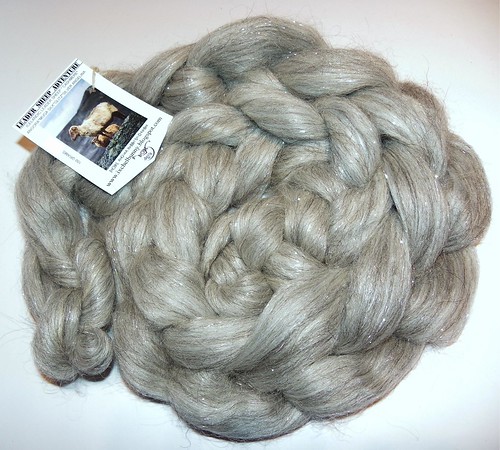
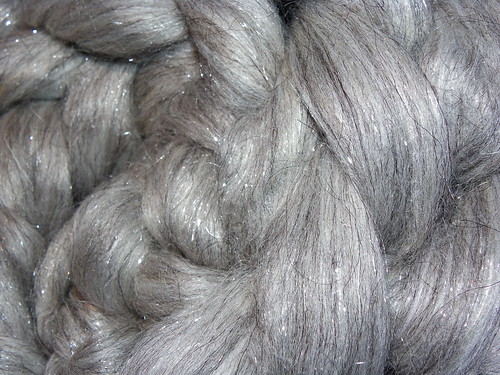
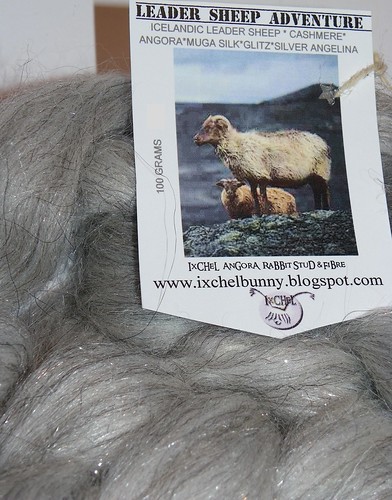
Icelandic Sheep Tops
100g tops natural mid grey, autumn shearing $23 SOLD...SORRYI only have a very limited amount of this special autumn shearing !!!
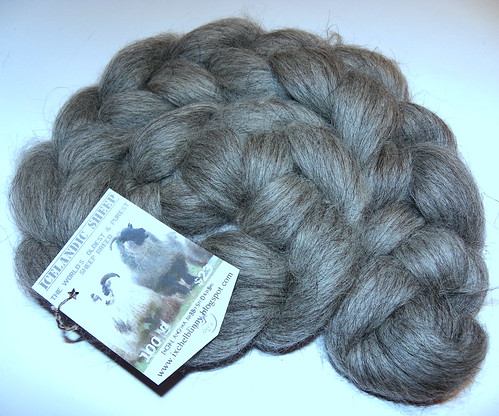
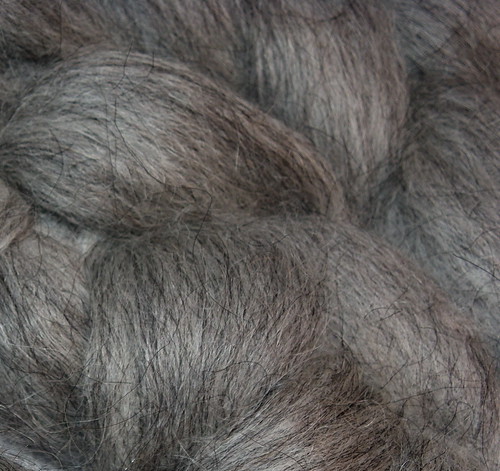
Dates to put in your Calendar !!
April 18th
Monday 10am-2pm
Grandvalley Spinners and Weavers Spin in
May
Saturday May 7th10am-3pmHealesville Spinners and Weavers Guild Chat, Spin and Shop
Please join me with the Healesville Spinners and Weavers on Saturday for their annual celebration.
I will be doing a talk about the IxCHeLbunny farm, fibres and yarns and lots more !!! There will be fibres to cuddle (and buy) and also spindles of all shapes and sizes.
The event is open to all but everybody is asked to bring a plate of food to share with the others to make it even more fun. The Hall opens at 11am with a group meeting and my talk will start around 12. After the talk there will be ample opportunity to browse, shop and mingle.
V.C. Mullett Hall (Badger Creek Hall), 358 Badger Creek Road, Badger Creek.
The hall is located next to the Badger Creek C.F.A. Station and opposite the Badger Creek Primary School. There is off road parking.
I will be doing a talk about the IxCHeLbunny farm, fibres and yarns and lots more !!! There will be fibres to cuddle (and buy) and also spindles of all shapes and sizes.
The event is open to all but everybody is asked to bring a plate of food to share with the others to make it even more fun. The Hall opens at 11am with a group meeting and my talk will start around 12. After the talk there will be ample opportunity to browse, shop and mingle.
V.C. Mullett Hall (Badger Creek Hall), 358 Badger Creek Road, Badger Creek.
The hall is located next to the Badger Creek C.F.A. Station and opposite the Badger Creek Primary School. There is off road parking.
Sunday May 29th10am-3pmVictorian Hand Knitters Guild Show Coburg Town Hall
THE extra ordinary super fluffy yarny event in Melbourne !!!
I will be there with lots of hand dyed tops for spinning and felting and happy rainbow yarn and sock yarn, some extra special art yarns and much much more!!!!
As well as some amazing Lair of the Bearded Dragon spindles and bowls that are pure magic to spin with !
I will be there with lots of hand dyed tops for spinning and felting and happy rainbow yarn and sock yarn, some extra special art yarns and much much more!!!!
As well as some amazing Lair of the Bearded Dragon spindles and bowls that are pure magic to spin with !
JULY
Friday July 15th- Sunday 17th, 9am-5pm
Bendigo Sheep and Wool Show
THE event of the year !!!! Not to be missed!! I will be there in the Flower (Power Bunny) Shed again with heaps of new goodies, hand dyed and hand spun, IxCHeL new blends and rare sheep breed adventures and much much more ! Including a world first of something AMAZING AND FUN!!!!! Shhh not telling ! but it is AWESOME !!!!
OCTOBER
2nd of October
Black n Coloured Sheep FIELD DAY in Cranbourne!
Landscape dyes
100g tubs AU$11
Want to dye your own with easy to use acid dyes? I have been selling these Landscape dyes at my workshops and shows for a long time : They are extremely easy to use and come in great shades.
Just contact me with the name of the colour you are after and I will get right back to you.
Just contact me with the name of the colour you are after and I will get right back to you.
Have a creative week!
Please don't hesitate to contact me at any time if you have any questions okay? : Always happy to enable.
All my contact details are here:
How To Order:
1. You can email me on ixchel at rabbit dot com dot au or ixchelbunny at yahoo dot com dot au
2. Message me on facebook or
3. Message me on www.ravelry.com where I am Ixchelbunny.
I will email you right back with all your order details and payment methods.
Any questions? Any custom orders for yarn or dyeing fibre? : Please don’t hesitate to ask! Always happy to enable.
2. Message me on facebook or
3. Message me on www.ravelry.com where I am Ixchelbunny.
I will email you right back with all your order details and payment methods.
Any questions? Any custom orders for yarn or dyeing fibre? : Please don’t hesitate to ask! Always happy to enable.
Thank you so much for your help and support !
RABBIT ON !
((hugs))
Charly




No comments:
Post a Comment